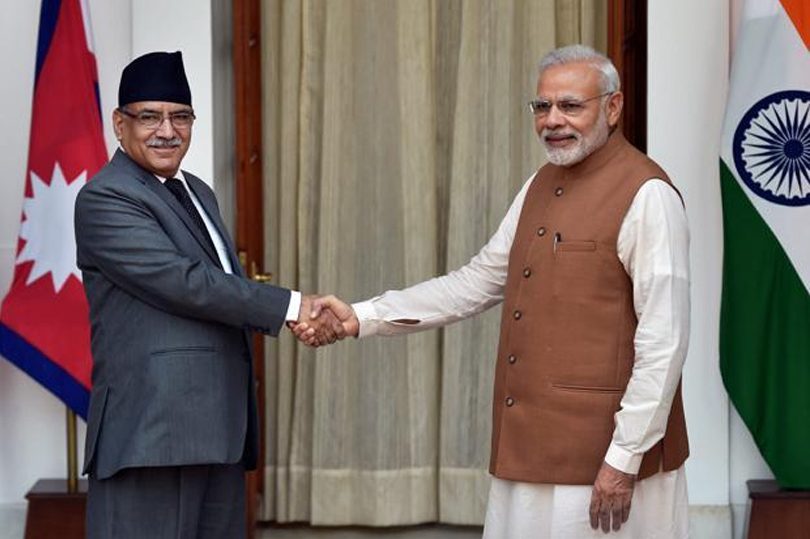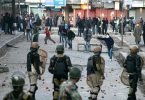“There is some self-interest behind every friendship. There is no friendship without self-interests. This is a bitter Truth” is the saying of Chanakya, the great Indian political and administrative genius who was born in 350 BC and died in 275 BC. Like Machiavelli who came centuries later, he has been demonized for preaching an immoral and treacherous doctrine which however can be contested on the basis that for him matters of statecraft left no room for morality and its use would do more harm than good to the common man.
Chanakya’s Maurya Empire is now divided among several new states of which India is the most prominent due to its territory, population and power. India shares a border with each state of South Asia with a few exceptions and it has territorial disputes with each state. The most significant being Pakistan which is perceived as the main obstacle in the fulfillment of Indian hegemony over South Asia.
Nonetheless, Indian relations with the rest of South Asia have not been exemplary either. It actively interferes in other sovereign nation’s policies especially foreign relations. For example it refused to arm Sri Lanka and tried actively to prevent other arm suppliers because according to Indian National Security Adviser M.K. Narayanan in 2008 “We have to ensure that India’s pre-eminent position in the region is not compromised by Sri Lanka seeking arms from elsewhere. We need a national consensus on how much (military) assistance we should provide and how much pressure we should put on the (Sri Lankan) government.”
India uses a host of methods to achieve its foreign policy objectives within the Indo-Pak subcontinent. It ranges from bilateral diplomacy, economic incentives, belligerent militarism as well as support to terrorist organizations like Sri Lanka’s LTTE & Bangladesh’s Shanti Bahini. It has also been asserted that it actively supports unpopular governments like in Bangladesh over the wishes of local populace as well as the international community in what could be a mirroring of US support to juntas and regimes all over the world.
In the recent times, Indian Nepal relations are asserted to be a prime example of Indian hegemonic policies with its smaller neighbors. On the face of it, India and Nepal should have the most cordial of relations. Both are Hindu majority nations and share common culture. Landlocked Nepal shares its longest border with India and is dependent upon India for many things, above all else access to the sea. Yet relations between the two states are not affable.
A ROCKY RELATIONSHIP
After Indian independence in 1947, relations between both Nepal and India had their foundation in the second Treaty of Sagauli signed with the colonial British masters of the subcontinent in 1925. In 1950, the relations were rebooted with two new treaties coming into force. In the Treaty of Peace and Friendship, ratified in July 1950, each government agreed to acknowledge and respect the other’s sovereignty, territorial integrity, and independence; to continue diplomatic relations; and, on matters pertaining to industrial and economic development, to grant rights equal to those of its own citizens to the nationals of the other residing in its territory. Agreements on all subjects in this treaty replaced those on similar matters dealt with in the previous treaties between Nepal and Britain. In the Treaty of Trade and Commerce, ratified in October 1950, India recognized Nepal’s right to import and export commodities through Indian Territory and ports. Customs could not be levied on commodities in transit through India.
These treaties were the start of India’s lingering interference in. The Citizenship Act of 1952 allowed both citizens of India and Nepal to immigrate to the other country and easily acquire citizenship which fueled resentment on both sides. This policy continued without stop until 1962 when several restrictive clauses were added to the Nepalese constitution. The year of 1952, saw the establishment of an Indian military mission in Nepal and in 1954 a memorandum was signed for the joint coordination of foreign policy, and formation of Indian security posts in the northern frontier of Nepal. Nevertheless, this period also saw the emergence of Nepal’s discomfort with the expanding Indian shadow and approaches to the People’s Republic of China commenced in order to counterbalance India.
Nepal’s ruler King Mahendra persisted to follow a policy of nonalignment which had been in place since the time of Prithvi Narayan Shah during the mid-eighteenth century. In the decades of the 1950s and 1960s, the world saw a divergence between Nepal and India in the UN where Nepal voted differently from its southern neighbor aside from a few selected places which involved Indian basic interests. A continued point of contention between the two states were the rights of landlocked states to transit facilities and access to the sea.
A substantial warming occurred in the relationship between Kathmandu and New Delhi after the 1962 Sino-India war. New Delhi put its support to India-based Nepalese opposition forces on the backburner. Nepal extracted several concessions, including transit rights with other countries through India and access to Indian markets. In exchange, through a secret accord concluded in 1965 India got exclusive rights on arms sales to Nepal.
In 1969 Indo Nepal relations saw new tensions as Nepal challenged the existing mutual security arrangement and asked for the Indian security check posts and liaison group to be withdrawn. The Treaty of Peace and Friendship of 1950 was also requested to be annulled. India grudgingly withdrew its military check posts and liaison group, although the treaty was not abrogated.
The decade of the 1970s saw events which caused shifts in the relationship. Power imbalance between India and Nepal was augmented – by the 1971 Indo-Soviet Treaty of Peace, Friendship, and Cooperation; the 1971 IndoPak War, which led to the emergence of an independent Bangladesh; the absorption of Sikkim into India in 1974; increased unofficial support of the Nepali Congress Party leadership in India; rebellions fomented by pro-Beijing Naxalite elements in 1973-74 in West Bengal State bordering Nepal; and India’s nuclear explosion in 1974. Nepal implemented a vigilant appeasement approach to India, and in his 1975 coronation address King Birendra advocated for the recognition of Nepal as a zone of peace where military competition would be prohibited. New Delhi tried to show some flexibility in placating Nepal by distancing, but not separating, itself from the Indian based Nepalese opposition, approving a favorable trade and transit arrangement in 1978, and entering into another arrangement on joint industrial ventures between Indian and Nepalese firms. The latter agreement, by opening the possibilities of India’s investment, secondarily advanced India’s control of Nepal’s economy which was simultaneously reinforced by a high level of Indian economic aid to Nepal.
India was persistent in supporting the Nepalese opposition and refused to endorse Nepal as a zone of peace. In 1987 India urged expulsion of Nepalese settlers from neighboring Indian states, and Nepal retaliated by introducing a work permit system for Indians working in Nepal. Relations between the two countries became tenser in 1988 when Kathmandu signed an agreement with Beijing to purchase weapons soon after a report that China had won a contract for constructing a road in the western sector to connect China with Nepal. India perceived these developments as deliberately jeopardizing its security. India also was annoyed with the high volume of unauthorized trade across the Nepalese border, the issuance of work permits to the estimated 150,000 Indians residing in Nepal, and the imposition of a 55 percent tariff on Indian goods entering Nepal.
In retaliation for these developments, India put Nepal under a virtual trade siege. In March 1989, upon the expiration of the 1978 treaties on trade and transit rights, India insisted on negotiating a single unified treaty in addition to an agreement on unauthorized trade, which Nepal saw as a flagrant attempt to strangle its economy. On March 23, 1989, India declared that both treaties had expired and closed all but two border entry points.
The economic consequences of the trade and transit deadlock were enormous. Shortages of Indian imports such as fuel, salt, cooking oil, food, and other essential commodities soon occurred. The lucrative tourist industry went into recession. Nepal also claimed that the blockade caused ecological havoc since people were compelled to use already dwindling forest resources for energy in lieu of gasoline and kerosene, which came mostly via India. To withstand the renewed Indian pressure, Nepal undertook a major diplomatic initiative to present its case on trade and transit matters to the world community.
The relationship with India was further strained in 1989 when Nepal decoupled its rupee from the Indian rupee which previously had circulated freely in Nepal. India retaliated by denying port facilities in Calcutta to Nepal, thereby preventing delivery of oil supplies from Singapore and other sources.
The relationship thawed again in the June 1990 New Delhi meeting of both Prime Ministers after the end of the Indian 13 month long economic blockade. Later on the two countries signed new, separate trade and transit treaties and other economic agreements designed to give Nepal supplementary economic benefits. New changes occurred when the Nepali prime minister visited in 1995 and insisted on a major review of the 1950 peace and friendship treaty as well as a greater economic independence of his country.
The ascension of king Gyanendra to the Nepalese throne saw a souring of relationships even though new talks and agreements took place which included revisiting the 1950 treaty. However, the end of the Hindu monarchy in 2008 saw a new paradigm in Indo Nepal ties. The burgeoning Maoist presence and increasing tilt towards China has prompted the Indian administration to use different economic incentives to wean away Kathmandu. New tensions have arisen in Indo Nepal relations after the passing of a new Nepalese constitution that sparked protests in Nepal and a new unofficial Indian blockade that has led to more suffering and hardship after the April 2015 earthquake.
NEIGHBOURS: FRIENDS OR RIVALS
The answer to this conceivably lies in the spectrum of power politics which is a form of diplomacy in which states guard their own interests by utilizing military, economic or political aggression. India is the most powerful nation in the Indo-Pak subcontinent and is considered to be the hegemon of the region by many scholars due to this fact. And like every hegemon, India desires to exercise its influence over its neighbors through a bilateral way in order to utilize its superior clout.
Initially, Indian policy of exerting influence over its neighbors with the exception of Pakistan has been through political interference. This is evident through the Awami League in Bangladesh, the current United National Front in Sri Lanka and through monarchs in Nepal. The monarchs were focused upon due to their dependence on a “Hindu” identity to sustain their rule against a Maoist uprising. This Hindu identity linked them to India, which not content to put all their eggs in one basket also hosted the Nepalese opposition on its soil.
The second phase that India applies is the phase of coercion which is most common with Pakistan either through military pressure (covert and overt) or economic sanctions. In the case of Nepal this method has been manifest through the application of a blockade in 1989 and 2015. India employs this phase once its political interference fails and the other government moves to a more independent position instead of a client state more desirous to New Delhi.
The current cause of ignition for the blockade was the passing of the constitution of Nepal. It sparked off violent protests by the Mahdesi community who live in the plains. They perceive that they will be underrepresented. Alluding to these protests, the Indian government has made the excuse of blocking main transit points into Nepal which has led to a fuel shortage. The Nepalese government has stated this to be another Indian blockade in order to influence the constitution to be more favorable to Indian designs and has cited safe havens to violent protestors inside India as proof.
The case of Nepal highlights a situation adverse to Indian designs and further augmented by ideological repercussions for the current Modi administration. The end of the Hindu monarchy saw the rise of democracy which ended the status of Nepal as the world’s only Hindu state. The constitution which is secular in nature will make Nepal’s demise as a Hindu state permanent. The ruling Indian party BJP, rooted in Hindutva, see this as a stumbling block in their quest for mutating the whole of the subcontinent into a Hindu rashtra. Hindutva’s ire can be seen in the form of protests, violence and terrorism inflicted on both sides of the Indo Nepal border.
The other point of concern for India is the large-scale presence of indigenous Maoist forces in the new Nepalese government. Not only are they ideologically allied to the Naxalite forces battling New Delhi’s rule in central India but are also more sympathetic to China, India’s perceived rival. As has been ascertained that this negates India’s policy to retain satellite states to maintain its hegemony.
THE PATH BEYOND
For landlocked Nepal whose nearest sea outlet is in India and already suffering from the April earthquake, there is not much in the way of options. The nearest country and neighbor China, is in a difficult position to help Nepal. Once the various power supply projects and CPAC become operational only then can China play an optimum role in being an alternative route.
In South Asia, the main obstacle to Indian hegemony is Pakistan which has been following a policy of security maximization in contrast to India’s power maximization. The size of Pakistan’s nuclear arsenal does not match its economic muscle and this, makes it difficult for Pakistan to replace India in regional roles. However, there are two ways to counter an aggressive Indian posture. One is either to bring in a counterforce to India i.e. China into SAARC (which is mainly dormant due to Indo Pak tensions), that may revitalize the organization and temper Indian belligerence.
The second way is to form a counter SAARC, an organization that spans the whole subcontinent minus India. The strategy of power balancing through external alliances is the way left to smaller powers when facing a hegemon. It also helps bolster regional integration. However that may seem improbable at the moment due to pro Indian establishments currently in power in three countries: Bangladesh, Sri Lanka and Bhutan. However this remains one of the surest way aside from Bandwagoning to counter Indian hegemony. Perhaps it is as Chanakya said “A ruler with a contiguous (sharing a border) territory is a rival. Power is the cause of an alliance.”







